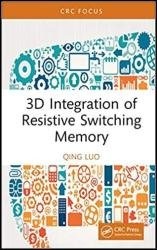 Название: 3D Integration of Resistive Switching Memory
Название: 3D Integration of Resistive Switching MemoryАвтор: Qing Luo
Издательство: CRC Press
Год: 2023
Страниц: 107
Язык: английский
Формат: pdf (true)
Размер: 44.1 MB
This book offers a thorough exploration of the three-dimensional integration of resistive memory in all aspects, from the materials, devices, array-level issues, and integration structures, to its applications.
Resistive random-access memory (RRAM) is one of the most promising candidates for next-generation nonvolatile memory applications owing to its superior characteristics including simple structure, high switching speed, low power consumption, and compatibility with standard complementary metal oxide semiconductor (CMOS) process. To achieve large-scale, high-density integration of RRAM, the 3D cross array is undoubtedly the ideal choice. This book introduces the 3D integration technology of RRAM, and breaks it down into five parts:
1: Associative Problems in Crossbar array and 3D architectures;
2: Selector Devices and Self-selective cells;
3: Integration of 3D RRAM;
4: Reliability Issues in 3D RRAM;
5: Applications of 3D RRAM Beyond Storage.
The development of social networking and the emergence of the Internet of Things (IoT) have led to an explosion in global data volumes. According to a report from Internet Data Center (IDC), the total amount of global data volumes will reach 175 ZB by 2025. However, in the traditional Von-Neumann architecture, there is a “memory wall” between DRAM and NAND Flash, which limits the performance of the entire computer system.
To tear down the “memory wall”, the solution of Storage Class Memory (SCM) was first proposed by Intel Corporation. SCM acts as the bridge between DRAM and NAND, which has a higher storage density than DRAM and a higher access speed than NAND FLASH. To achieve high-density SCM, memories are often required to have the advantage of three-dimensional (3D) integration. In addition to the 3D stacking with conventional Flash memory cells, some emerging memories, such as PCRAM and RRAM, have intrinsic advantages for SCM applications.
According to the different integration methods, 3D crossbar arrays can be classified into two types. One is a 3D X-point structure, which is a multi-layer stack of planar crossbar arrays, and the other one is a vertical crossbar array structure (3D VRRAM), which is similar to BICS 3D NAND. Each layer of the crossed-array structure of the 3D X-point structure needs to be manufactured separately. The advantage of the 3D X-point structure is that the storage density per unit area can be improved while the 3D stacked structure is easy to integrate. For the vertical 3D structure of 3D VRRAM, the number of lithograph does not increase significantly with the number of stacking layers increased, which significantly reduces the number of lithographs. Compared to other multi-layer stacked structures, the costs can be significantly diminished for 3D VRRAM.
The book aspires to provide a relevant reference for students, researchers, engineers, and professionals working with resistive random-access memory or those interested in 3D integration technology in general.
Скачать 3D Integration of Resistive Switching Memory